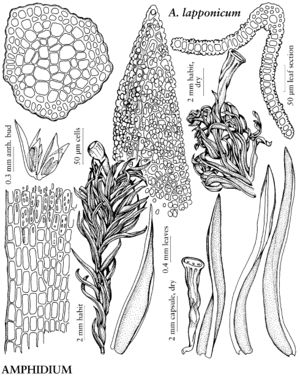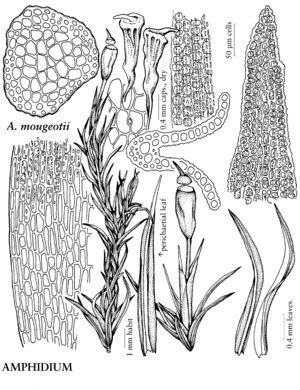Plants small to large, in tufts, cushions, or mats, dark green, reddish brown, or olive brown, dull. Stems erect-ascending and often 2-fid, or creeping, branches many, erect or ascending, simple or 2-fid; outer cell walls thick, central strand absent, inner cells uniform, walls thin. Leaves erect-appressed, crowded, spirally twisted, flexuose, crisped, or contorted when dry, erect-spreading to squarrose-recurved when moist, ovate-lanceolate, ligulate-oblong, or lanceolate-linear, ± channeled; base not decurrent (decurrent in Zygodon); margins usually plane to revolute, rarely involute to erect, entire or sometimes denticulate near apex; apex rounded-obtuse, acute, occasionally acuminate, apiculate, or awned; costa strong, ending near apex; alar cells rarely differentiated; basal laminal cells rectangular, elongate-linear, quadrate, rounded, or elliptic; distal cells rounded-hexagonal, rarely rectangular, usually small, papillae 1–4(–6) per cell, conic or 2-fid, rarely smooth or mammillose, walls often incrassate. Specialized asexual reproduction occasional, by gemmae. Sexual condition usually gonioautoicous or dioicous, rarely pseudautoicous or cladautoicous; perigonia terminal or lateral, sometimes occurring on dwarf male plants, budlike, large; perichaetia terminal, further branching occurring by innovations, perichaetial leaves sometimes larger than stem leaves. Seta erect, dextrorse or sinistrorse, smooth or rarely rough. Capsule erect, immersed, emergent, or exserted, ovate to cylindric-fusiform, symmetric, smooth or 8-ribbed, rarely 16-ribbed, sometimes constricted below mouth; exothecial cells rectangular to elliptic, often differentiated into bands; stomata superficial or immersed, usually below mid capsule, well developed; annulus poorly developed or absent; operculum convex to conic, rostrate; peristome double, single, rudimentary or rarely absent; prostome sometimes present, usually fragmentary; exostome teeth 16, usually connate in 8 pairs, erect, recurved, or reflexed, lanceolate, thick, densely papillose or striate; endostome segments 8 or 16 when present, hyaline, thin, linear-lanceolate, alternating with exostome teeth or connate to form rudimentary membrane, cilia absent. Calyptra mitrate or rarely cucullate, usually large and conspicuous, hairy or naked, plicate or not. Spores isosporous or anisosporous.
Distribution
Nearly worldwide.
Discussion
Genera 22, species ca. 380 (9 genera, 71 species in the flora).
Selected References
Lower Taxa
Illustrations
Key
| 1 | Plants in dense cushions; leaves linear to narrowly lanceolate; distal laminal cells papillose over lumina and transverse walls. | Amphidium |
| 1 | Plants in tufts, loose cushions, or mats; leaves lanceolate-ligulate or broader; distal laminal cells smooth or mammillose to papillose only over lumina | > 2 |
| 2 | Plants in tufts or loose cushions; stems and branches erect to ascending (stems creeping in Orthotrichum kellmanii) | > 3 |
| 2 | Plants usually in loose mats; stems creeping, branches ascending or erect | > 5 |
| 3 | Distal laminal cell papillae 2-6, clavate (cells smooth in Z. menziesii); setae 3-13 mm; capsules long-exserted; calyptrae cucullate. | Zygodon |
| 3 | Distal laminal cells smooth or papillae 1-4, 2-fid, conic, or clavate; setae 1-10 mm; capsules immersed to exserted; calyptrae mitrate | > 4 |
| 4 | Leaves erect-appressed and straight when dry; marginal laminal cells gradually shorter than basal; calyptrae covering entire capsule; stomata superficial or immersed. | Orthotrichum |
| 4 | Leaves straight and not crisped to flexuose and crisped when dry; marginal laminal cells abruptly shorter than basal; calyptrae covering 1/2 capsule; stomata superficial. | Ulota |
| 5 | Marginal laminal cells distinct from basal; basal laminal cells oblate to rounded. | Groutiella |
| 5 | Marginal laminal cells not distinct from basal; basal laminal cells elongate, quadrate, rounded, or elliptic | > 6 |
| 6 | Calyptrae cucullate; leaves broadly lanceolate to oblong-lanceolate, not rugose; spores multicellular. | Drummondia |
| 6 | Calyptrae mitrate; leaves ligulate or lanceolate, rugose or not; spores unicellular | > 7 |
| 7 | Distal laminal cells 5-9 µm, in diagonal rows; calyptrae not plicate, basal lobes 4-6. | Schlotheimia |
| 7 | Distal laminal cells 7-12 µm, in vertical rows; calyptrae plicate or obscurely plicate, basal lobes many | > 8 |
| 8 | Capsules oblong-cylindric to fusiform; leaves erect-appressed, not contorted when dry; margins entire; basal laminal cells rounded to elliptic. | Macrocoma |
| 8 | Capsules ovate to ovate-oblong; leaves strongly crisped and inrolled, rarely erect-appressed when dry; margins entire to crenulate; basal laminal cells rectangular to elongate-linear. | Macromitrium |


